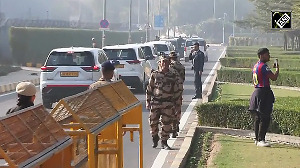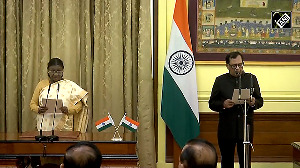The situation in the Pashtun belt of the Federally-Administered Tribal Areas and the North-West Frontier Province of Pakistan has rapidly deteriorated after the commando raid on the Lal Masjid of Islamabad between July 10 and 13, 2007.
The tribals, many of whose children, particularly girls, were killed during the raid, have hit back with ferocious vengeance at the Pakistan Army, paramilitary forces and the police deployed in the Pashtun belt as well as outside.
The Al Qaeda and pro-Al Qaeda organisations such as the Islamic Movement of Uzbekistan and the Islamic Jihad Group have taken advantage of the tribal anger to advance their own anti-US and anti-Israel agenda. One has been seeing a Fallujah 2003-4 like situation developing in the tribal belt.
There are presently two parallel jihads in the tribal area. The first is a Taliban-like ideological jihad, which is directed against those sections of civil society which are influenced by liberal ideas and lifestyle.
As part of this jihad, there has been a systematic destruction of all cultural influences such as music records, videos of films, TV sets etc and attacks on the independence and powers of women.
The second is a jihad of reprisals directed against the security forces -- the army, the paramilitary forces and the police.
The security forces have been facing increasing difficulty in coping with this jihad. The police, long neglected and humiliated by President General Pervez Musharraf, is in a state of paralysis.
Large sections of the paramilitary forces and some sections of the army are demoralised, resulting in increasing desertions and a jihad fatigue. There is very little flow of intelligence.
While Al Qaeda's propaganda and Psywar machine (As-Sahab) have been exploiting this anger, there is very little evidence of the involvement of Arabs of Al Qaeda in the jihadi strikes.
Evidence till now points to the involvement of only Uzbeks, Tajiks, Chechen and Uighurs. What one has been seeing is not a Salafi virus spreading from the Arab world, but an extremist virus spreading from Central Asia and Afghanistan
Without making amends for the large number of tribal girls (about 300) from the FATA killed in the Lal Masjid raid, it is doubtful whether the Musharraf government will be able to mitigate the anger.
The Pakistani media has been covering the situation in great detail and commenting on it. Relevant extracts are given below:
The Dawn on September 27, 2007: 'The government is hopelessly dependent upon the dubious goodwill of the moderates among the tribal chiefs, its own military machine being unable to compel the militants to release the kidnapped. This being the harsh reality, one wonders what is the purpose behind deploying nearly 100,000 soldiers in what is increasingly turning into a wild goose chase.
'Pakistan has lost 730 soldiers in the war on terror in the FATA, 229 since July 15 alone. Across the border, the US-led coalition forces have since July 15 suffered only 69 casualties. Have the security forces personnel in FATA developed battle fatigue? Or are they reluctant to fight and kill their own compatriots?
'One can understand a couple of soldiers being taken by surprise and kidnapped, but the very idea of such a large posse of well-trained and well-armed troops being kidnapped without a shot being fired defies logic.
'The deal the government made with the militants in September 2006 failed to produce results. More ominously, the number of tribal maliks who could be called moderate, if not pro-government, seems to be declining. This is also an indication of the collapse of FATA's traditional system in which the maliks commanded authority and acted in close liaison with the government to tackle recalcitrant elements. Now the maliks' power seems to have given way to that of the Taliban, who have gone on the offensive with a vengeance after the Lal Masjid crackdown.'
The Nation on September 27: 'The situation in Swat is precarious, specially since July. There have been four incidents of suicide bombings, all but one specifically targeting law enforcement agencies. As a result, there has been a significant reduction in the police patrolling of the district.
'Many police posts have been vacated. Many policemen have also deserted the force. The answer to this is definitely not getting the army in. The police, an ill-equipped and ill-paid force, needs to be reformed and corrected. If they had a fraction of the resources the military and paramilitary forces had at their disposal, we would not be having a lot of our current law and order problems.'
The Daily Times of September 27: 'The North-West Frontier Province government has finally called for army deployment at 12 sensitive points in the Swat district. Swat and towns lying near it have come under attack from elements of Talibanisation since July, spearheaded by trademark suicide bombings that have the police running scared and have, in one instance, targeted an army convoy.
'Since Swat was attacked by the FM (FM radio) -- Mullah Maulana Fazlullah, on behalf of Al Qaeda in Waziristan -- the Peshawar government has been biting its nails instead of acting. Fazlullah is the son-in-law of of the leader of Tehrik Nifaz Shariat Muhammadi, who led thousands of Pashtun youths into Afghanistan in 2001 and is now in a Pakistani jail.
'The police has simply run away and the citizens of the Swat Valley have been asked to fend for themselveas. The citizens have therefore accepted the rule of Fazlullah and one can expect them to go the way of the people of South Waziristan now being ruled by Al Qaeda proxies.'
The Dawn on September 27: 'When the insurgents come under pressure, they strike targets outside their zone of operations as they did in Mardan, Hangu, Kohat, Dera Ismail Khan, Kharian, Quetta, Swat, Islamabad, Rawalpindi and Tarbela.
'In the process, they have also conveyed a message to the government that they can strike anywhere at any time. After the Special Services Group operation against Lal Masjid, they had warned of revenge. By striking at Tarbela (SSG headquarters), they have taken their revenge.
'As a result, military installations across the country have become more vulnerable and the sense of fear and uncertainty in the minds of their commanders more intense. The insurgents fighting the army have close affinity with the Taliban. They not only enjoy the support of the local population, but also have the sympathy of the people outside their area. As a result, they have developed an effective intelligence network that enables them to stay a few steps ahead of the army.
'They are battle-hardened and skilled in guerilla tactics and techniques. They know the local terrain well. They are highly motivated. The soldiers, on the other hand, do not know the terrain well. They lack the support of the local people -- which also makes it difficult for the military intelligence to operate freely in this area.'
'It was lack of correct intelligence that led to the capture and killing of 18 SSG commandoes when they landed by helicopter on a hilltop in Waziristan for an operation. Above all, the level of motivation of the soldiers when fighting their own people is as low as it is high when fighting an external enemy.
'It was this factor, more than any other, which led the 300 armed soldiers to give themselves up to a small band of insurgents and it continues to manifest itself in the abductions of armed personnel of the security forces almost on a daily basis.
'The heavy casualties, the surrender of 300 soldiers, the daily abductions, the attack in Tarbela, the killing of heli-landed commandoes and the sting of defeats suffered by the security forces have clearly had a demoralising effect on them. The effect has been exacerbated by the fear that by fighting their own people, they will not become shaheed (martyrs) and, if they die, they would have died in vain like those who lost their lives in Kargil (in 1999).
'After the army crackdown in East Pakistan in March 1971, the Bengali soldiers of the army had deserted and joined the Mukti Bahini resistance force. In the tribal areas, a number of desertions by paramilitary forces are reported to have taken place. One hopes and prays that Pathan soldiers, who constitute nearly 30 per cent of the army's rank and file, remain unaffected.'
The Dawn of September 29: 'Highly disturbing is the absence of an institutional response from either Gen Mushaaraf or his surrogates in government to the series of abductions of the military's soldiers and paramilitary forces, which should have sent red alert signals to all policy-makers.
'The army abductions are non-discriminatory in nature. They are not restricted to junior level officers. The 19 Frontier Corps militiamen abducted from South Waziristan in August 2007 included a senior officer and a political tehsildar. The 280 soldiers abducted later included a Colonel and nine other officers.
'On September 1, another 10 FC paramilitary soldiers and a Major were kidnapped in FATA's Mohmand agency. These are clear proof of the growing confidence of the militants, who now use abduction as an effective way of pressing the regime to submit to their demands.
'The attacks now carry a clear political as well as violent message. The fearlessness of the militants stems from the success of the abduction of the FC militiamen in the second week of August. During the time they held down the soldiers, the militants released a video titled Revenge, exposing the brutal beheading of one of the abducted soldiers at the hands of a teenaged boy.
'The video ran a commentary that ended in questions relating to the legitimacy of the Jamia Hafsa (girls madrasa inside the Lal Masjid) operation, the detention of A Q Khan, the Balochistan operation and the forced disappearances of civilians.
'The attacks now focus increasingly on breaking down the confidence and resolve of the enemy. If the purpose of the video was to shock the audience, it did the job. It took a small group of Taliban fighters to force the surrender of 280 armed soldiers by merely blocking their convoy. As the twin attacks in Rawalpindi and later Tarbela show, high security zones no longer deter suicide attackers.'
The Nation on October 2: 'The situation in Waziristan deteriorated when the militants holed up in the Lal Masjid in Islamabad openly challenged the writ of the state. Massive deployments of troops in FATA, especially in north and south Waziristan, has failed to curtail terrorism emanating from there. FC posts and road troops convoys have become easy targets for the terrorists. Large number of troops have been killed and kidnapped. The government must come up with a new strategy and policy.'
The Jang on October 3: 'A new country has emerged between Pakistan and Afghanistan. This has not come up so far officially, but practically it exists there as there is no writ of the governments in this area and those, who claim to be the legitimate heirs of this territory, are handling the law and order there... A new map, which is emerging in areas of Pakistan and Afghanistan, covers FATA, Deer, Bajaur, Malakand, Khyber, Mehmand, Chitral and the southern provinces of Afghanistan. In these areas no border exists as the people there do not accept any man-made border there.'
The writer is additional secretary (retired), Cabinet Secretariat, Government of India, New Delhi, and, presently, director, Institute For Topical Studies, Chennai. He is also associated with the Chennai Centre For China Studies. E-mail: seventyone2@gmail.com





